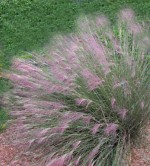 One of the most delightful plants native to North Carolina is purple muhly grass. Although it is hardy in zones 7-9 I had never seen it until I moved to North Carolina but it was love at first sight. It is a deciduous grass and grows very inconspicuously until it bursts into bloom with a stunning cloud of pinkish lavender in September. The flowers rise 2-3’ above the foliage often obscuring the leaves. The lavender flower color goes well with the burgundy fall color of other plants and creates an incredible effect in the morning when it is covered with dew. It is especially effective when planted in drifts with other grasses. The flowers are lovely in fall arrangements.
One of the most delightful plants native to North Carolina is purple muhly grass. Although it is hardy in zones 7-9 I had never seen it until I moved to North Carolina but it was love at first sight. It is a deciduous grass and grows very inconspicuously until it bursts into bloom with a stunning cloud of pinkish lavender in September. The flowers rise 2-3’ above the foliage often obscuring the leaves. The lavender flower color goes well with the burgundy fall color of other plants and creates an incredible effect in the morning when it is covered with dew. It is especially effective when planted in drifts with other grasses. The flowers are lovely in fall arrangements.
Type: Deciduous grass.
Bloom: Delicate pinkish-lavender flowers create a delicate haze over the foliage in late August and mature to tan by November.
Size: 2-4’ H x 2’ W.
Light: Full sun, tolerates light shade but will not bloom as well as plants grown in full sun.
Soil: Sandy or rocky soil with excellent drainage.
Fertilizer: Fertilize in early summer with 10:10:10.
Hardiness: Zones 7-9.
Care: Allow the seed heads to remain on the plant until mid winter so that the seeds can drop and produce new plants that can be transplanted to establish new clumps.
Pests and Diseases: No known pests or problems.
Propagation: Seed or division.
Companion plants: Other grasses, fall blooming mums.
Comment: The grass is rather plain until it comes into bloom so place it behind other plants.

Do you know if this grass is deer resistant? Those darned critters eat everything else we have.
Rosa,
Fine Gardening lists muhly grass as “deer tolerant” so at least their foraging will not kill it Deer resistance is relative and dependent in large part on what else is available for the deer to eat so may vary from one year to the next. My bet is that your deer would eat the muhly grass but the grass will return. Karen